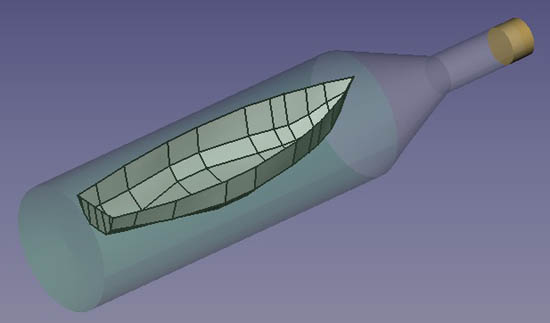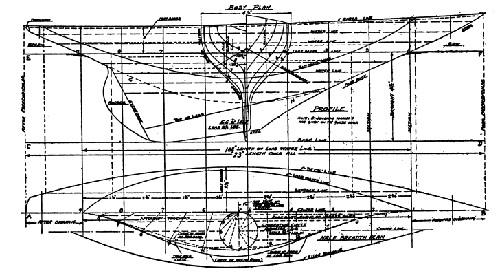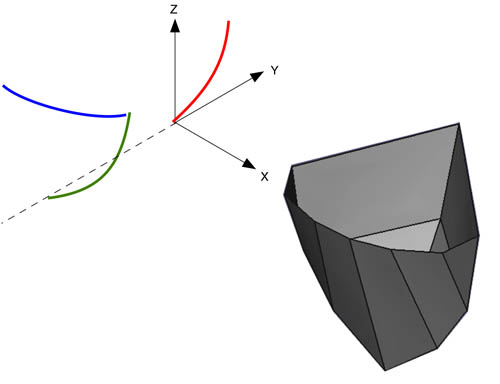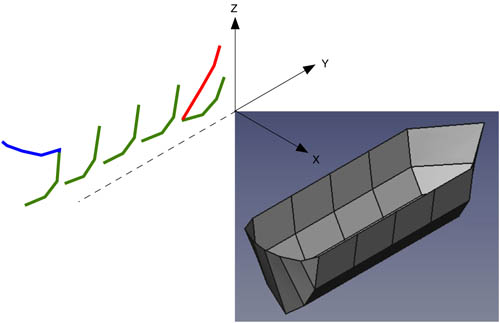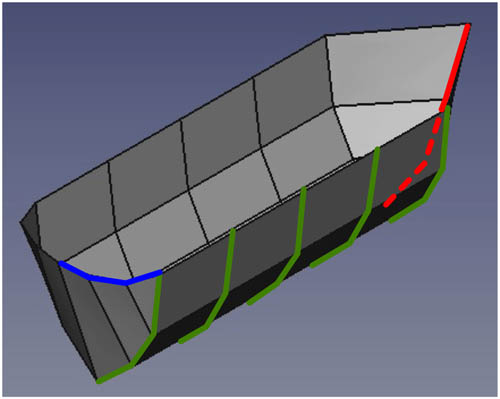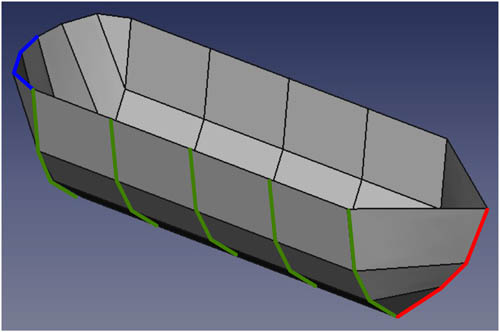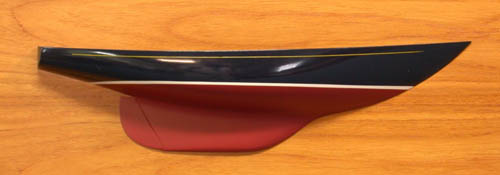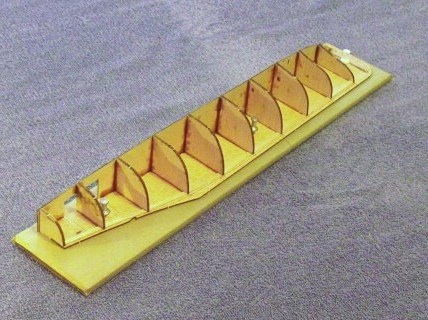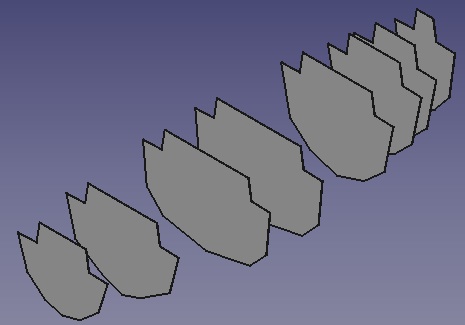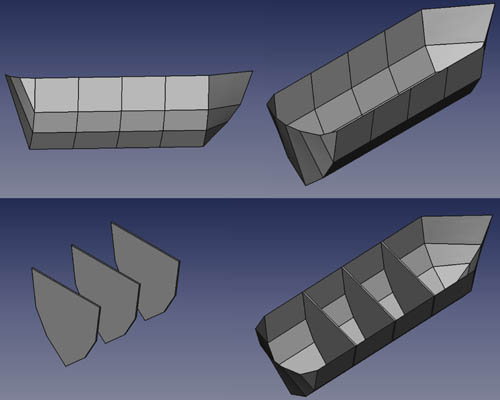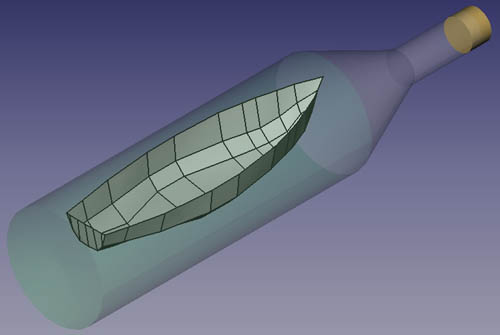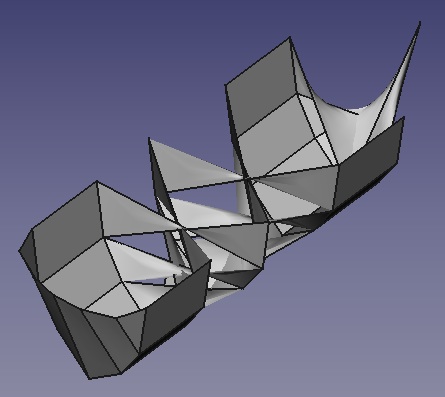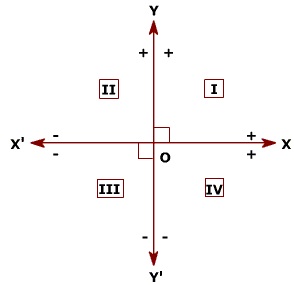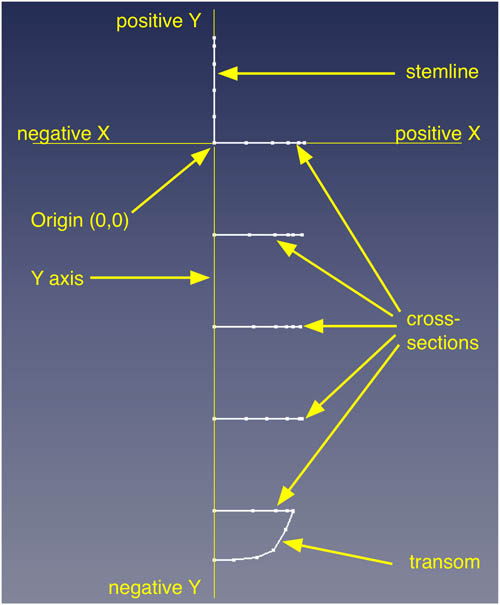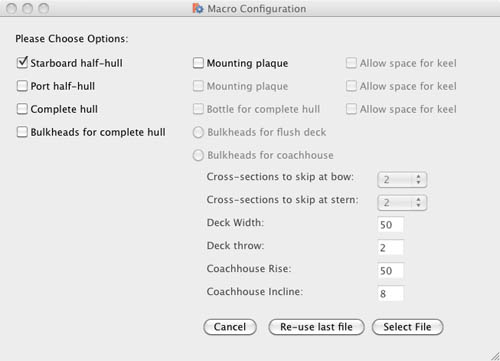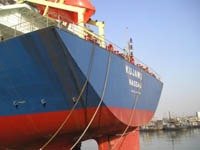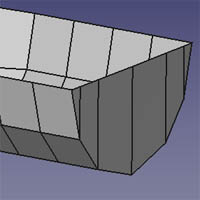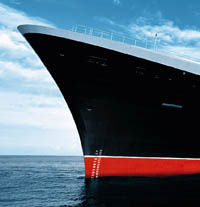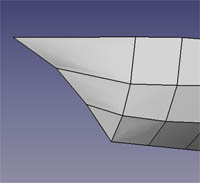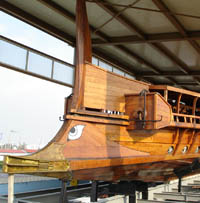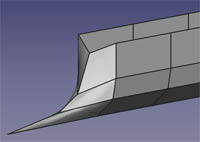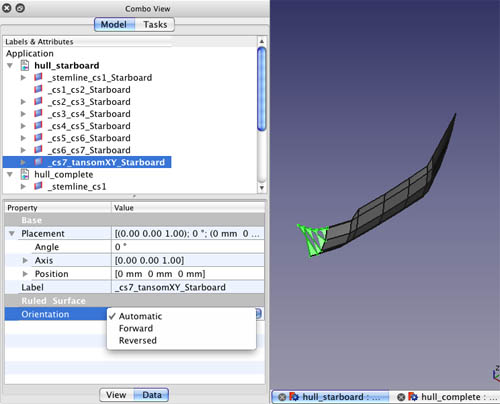Macro Half-Hull Model/de
| Beschreibung |
|---|
| Dieses Makro erzeugt sowohl dreidimensionale Halb- als auch Vollrumpfmodelle aus einer Reihe von 2D-Linienzeichnungen. Dieses Makro erstellt einfache Modelle der Rümpfe von Booten und Schiffen. Es soll Menschen helfen, die Rümpfe modellieren oder entwerfen, indem es die Oberfläche des Rumpfes in einer einfachen und zeitnahen Weise bereitstellt, so dass sie den zeitaufwendigen vollständigen Prozess vermeiden können. Versionsmakro : 1.0 Datum der letzten Änderung : 2016-01-25 FreeCAD version : <= 0.16 Herunterladen : Werkzeugleisten-Symbol Autor: Piffpoof |
| Autor |
| Piffpoof |
| Herunterladen |
| Werkzeugleisten-Symbol |
| Links |
| Makros Rezepte Wie man Makros installiert Symbolleisten anpassen |
| Macro-Version |
| 1.0 |
| Datum der letzten Änderung |
| 2016-01-25 |
| FreeCAD-Version(s) |
| <= 0.16 |
| Standardverknüpfung |
| None |
| Siehe auch |
| None |
Beschreibung
Dieses Makro erstellt einfache Modelle der Rümpfe von Booten und Schiffen. Es soll Personen, die Rümpfe modellieren oder entwerfen, helfen, indem es die Oberfläche des Rumpfes auf einfache und zeitnahe Weise bereitstellt, so dass sie den zeitaufwändigen vollständigen Prozess vermeiden können.
Temporary code for external macro link. Do not use this code. This code is used exclusively by Addon Manager. Link for optional manual installation: Macro
# This code is copied instead of the original macro code
# to guide the user to the online download page.
# Use it if the code of the macro is larger than 64 KB and cannot be included in the wiki
# or if the RAW code URL is somewhere else in the wiki.
from PySide import QtGui, QtCore
diag = QtGui.QMessageBox(QtGui.QMessageBox.Information,
"Information",
"This macro must be downloaded from this link\n"
"\n"
"http://pastebin.com/raw/tZMpUi6F" + "\n"
"\n"
"Quit this window to access the download page")
diag.setWindowFlags(QtCore.Qt.WindowStaysOnTopHint)
diag.setWindowModality(QtCore.Qt.ApplicationModal)
diag.exec_()
import webbrowser
webbrowser.open("http://pastebin.com/raw/tZMpUi6F")
Hintergrund
Seit der Antike mussten Bootsbauer Boote entwerfen und sie dann in einer dreidimensionalen Umgebung realisieren, in der nur wenige Linien gerade, nur wenige Flächen eben und keine Winkel über eine Strecke konstant sind. Anhand von Rumpfmodellen wurden maßstabsgetreue Modelle angefertigt, die dann zur Überprüfung des Entwurfs oder zur Kommunikation von Konzepten mit anderen Personen verwendet werden konnten. Die Gesetze der Hydrodynamik verlangen, dass jedes Schiff, das sich durch eine Flüssigkeit bewegt, im Querschnitt symmetrisch sein muss, wenn es genau verfolgt werden soll (sich in einer geraden Linie bewegen soll). Folglich genügte es, eine Seite des Rumpfes im Modell zu bauen - wenn der halbe Rumpf perfekt war, dann würde auch sein Spiegelbild perfekt sein. In späteren Jahren wurden Halbrümpfe für symbolische Zwecke wie Plaketten und nautische Kunst verwendet.
Dieser Code entstand aus einem Projekt zur Erstellung eines Modells in FreeCAD von einem 12,5 Meter langen Segelboot. Die Erbauer hatten keine Zeichnungen mehr und der Sohn des ursprünglichen Besitzers bezweifelte, dass es jemals vollständige Zeichnungen gab. Folglich mussten die Rumpfabmessungen gemessen und dann ein Modell in der Software konstruiert werden. Moderne Softwarepakete wie FreeCAD bieten viele vorteilhafte Funktionen wie Symmetriebeschränkungen, aber wenn die endgültige Messung ein Modell ist, das "einfach zu sehen" ist, ist viel "Massieren" von Modellen erforderlich. Dieser Code wurde geschrieben, um diesen Prozess zu automatisieren.
Der ursprüngliche Zweck dieses Codes war es, einen symmetrischen Rumpf bereitzustellen, der formbar war, damit er an das zu konstruierende 3D Modell angepasst werden konnte. Im weiteren Verlauf wurde die Software verallgemeinert, so dass sie hoffentlich für Personen von Nutzen sein wird:
- Bootskonstrukteure, die Bootspläne erstellen, aus denen gebaut werden kann
- Bootsbauer, die versuchen, das zu modellieren, was auf ihren Plänen beschrieben ist
- Modell Rumpf Bauer.
Sicherlich haben gewerbliche Bootskonstrukteure alle Arten von High End Software, um ihre Arbeit zu unterstützen, dies ist nicht dazu gedacht, dies zu ersetzen. Vielmehr ist dies für den Bastler oder Heimwerker zum Herumtüfteln gedacht.
Nautische Blaupausen haben eine eigene Geschichte in Bezug auf Bauten und sind daher etwas anders in der Darstellung. Dies ist ein Beispiel für ein Segelboot, das mehr als ein Jahrhundert alt ist:
Eines der Endziele dieser Software ist es, mit der Entwurf Arbeitsbereich einige dieser Pläne zu generieren, indem das Modell zur Erzeugung der Linien verwendet wird.
Hinweis zu Einheiten in FreeCAD:
Zur Zeit gibt es kein wirkliches Einheiten Handhabungssystem in FreeCAD, aber natürlich braucht ein Bootsbauer oder Modellbauer ein genaues Bemaßungssystem. Um dieses Makro zu verwenden, entscheide dich, die FreeCAD Rastergröße auf das einzustellen, was immer für deine Arbeit angemessen ist (z.B. mm, cm, Zoll, Fuß). FreeCAD ist konsistent, eine FreeCAD Einheit wird immer gleich einer FreeCAD Einheit sein. Und wenn du dich entschieden hast, dass eine FreeCAD Einheit einer bestimmten physikalischen Länge entspricht, dann werden deine Zeichnungen konsistent bemaßt bleiben. Zur Zeit wird an einem Einheitensystem für FreeCAD gearbeitet, so dass sich diese Situation bald ändern könnte.
Beschreibung
Für dieses Makro werden die Rumpfformen durch ein Minimum von 3 FreeCAD-Skizzen definiert: eine in der YZ-Ebene, eine oder mehrere in der XZ-Ebene, eine in der XY-Ebene. Hier ist der minimale Rumpf, der von diesem Makro unterstützt wird, er hat nur 3 Skizzen:
Anmerkung: In der obigen Abbildung schauen wir direkt auf das Heck, der Bug zeigt vom Standpunkt weg.
From front to back (bow to stern) the 3 Sketches are:
| stemline |
YZ plane |
red line in sketch |
| cross-section |
XZ plane |
green line in Sketch |
| transom |
XY plane |
blue line in Sketch |
Vielleicht ist es mit 7 Skizzen (eine in der YZ Ebene, eine in der XY Ebene und 5 in der XZ Ebene) einfacher zu sehen:
Mit 5 Skizzen in der XZ Ebene wird es immer einfacher, die Form des Rumpfes zu erkennen. Die nächsten 2 Bilder zeigen die Skizzenlinien, die dem von FreeCAD konstruierten Modell überlagert sind,
das zweite ist das gleiche Modell um 90 Grad gedreht, so dass der Bug im Vordergrund ist:
Einige Punkte, die zu beachten sind:
- the Sketches are only for:
- the stemline (or bow line) in the YZ plane (red in the above diagram);
- the top of the transom in the XY plane (blue in the above diagram);
- multiple cross-sections of the hull in the XZ plane (green in the above diagram)
- only the starboard side of the hull is drawn in the Sketches, the port side will be generated as a mirror image
- each multiple-segment line must be in a separate Sketch
- each Sketch must have the same number of line segments (which is 3 in the previous examples)
- the more line segments in each Sketch, the closer the FreeCAD generated model will approximate a curved hull
- there is no limit to the number of line segment in each Sketch, any number from one up
- there is no limit to the number of Sketches in the XZ plane (i.e. cross-sections), any number from one up
Mit genügend Skizzen kann sich das generierte Modell sogar annähern an:
Das HalbRumpf Makro erzeugt 4 Modelle:
- starboard half-hull
- port half-hull
- complete hull
- bulkheads for the complete hull, either with a flush deck or with a coachhouse
These models are all output in the unified location space of FreeCAD so they can be fitted together, for example the bulkheads can be inserted into the complete hull seamlessly. This is a picture of bulkheads in a boat model during construction:
Sowie die durch das Makro erzeugten Schotten (beachten Sie, dass diese Schotten für ein Kajütdeck und nicht für ein Flushdeck bestimmt sind):
The composite image below shows the main outputs from this software (the port side half-hull is actually not shown but it is the mirror of the starboard half-hull which is shown). The outputs are in clockwise order from the upper left corner:
- starboard half-hull
- complete hull
- bulkheads (for flush deck, the bulkheads in the previous image were for a coachhouse deck)
- the complete hull with the bulkheads inserted
Als neue Funktionen kann das Makro optional auch Plaketten für die Halbschalen und sogar eine Flasche für den kompletten Rumpf erstellen:
Installation
All the code for halfHullModel.FCMacro is in one macro. So installation is comprised of copying the code to the appropriate Macro directory and invoking the Build Utility from the Macro menu, the Python console or a toolbar button (the preferred method).
- see How to install macros for information on how to install this macro code
- see Customize Toolbars for information how to install as a button on a toolbar
Anwendung
The FreeCAD operations involved in generating the hull model are rather complex and numerous. Things like the direction a line is drawn can cause the FreeCAD construction of the hull to either abort or turn out like:
Consequently the steps below need to be followed closely. The macro does allow for certain data inconsistencies but generally if the data (i.e. the Sketches) are incorrect then the output will look like a cheese grater or the macro fill fail with an error.
Die folgenden Anweisungen beziehen sich auf die Quadranten des XY-Diagramms, d. h. auf die vier Viertel des XY-Diagramms, die wie folgt bezeichnet sind:
Ein neues Dokument erzeugen
Als Erstes erstellen Sie ein neues Dokument in FreeCAD . Dieses Dokument enthält alle Skizzen, aus denen sich die Rumpfdefinition zusammensetzt.
Erstellen Sie die Buglinie
Der erste Schritt besteht darin, Daten für das zu erstellende Rumpfmodell zu erstellen. Die Daten werden in Form von Skizzen innerhalb von FreeCAD bereitgestellt. Nachdem das Rumpfmodell erstellt wurde, können Änderungen einfach durch Bearbeiten der Skizzen vorgenommen werden. Der zweite Schritt besteht darin, das Makro wiederholt auszuführen.
- create a new sketch
, in the YZ-Plane
- start at origin (0,0) and draw upwards into Quadrant I
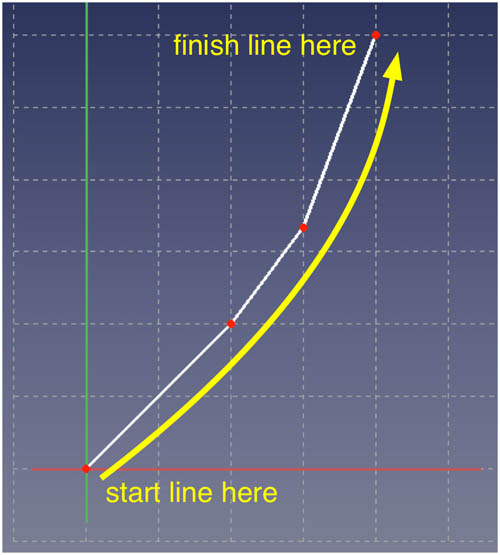
- the bottom end of the stemline is at the origin (0,0). This will be the point from where the placement of all the cross-sections and transom will be made
- the number of line segments in this Sketch determines the number which will be required in each other Sketch
- save sketch
- for ease of identification it is probably worth naming the Sketch something like "stemline sketch"
Create the Cross-section Sketch(es)
- create a new sketch
, in the XZ-Plane
- the following dialog will appear:
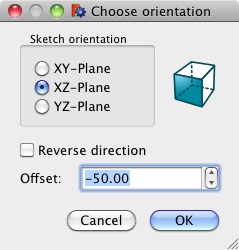
The dialog is asking how far from the origin the Sketch should be placed. This will refer to how far the cross-section is from the bottom of the stemline (which was placed at (0,0)). The cross-sections can be equally spaced but need not be. The forward-most cross-section will be at Y=0 (i.e. the origin where the stemline bottom ends) or at Y<=0. The cross-sections will be at increasingly negative Y values until the transom is at the most negative Y value. In the example above, the cross-section Sketch will be placed 50 FreeCAD units from the origin on the negative Y axis. - start on the Y axis and draw upwards into Quadrant I
- the first (i.e. foremost) cross-section should start at origin (0,0) (or it will look odd as the stemline ends at 0,0) but other cross-sections need only start on the Y axis.
- use the same number of line segments as in the Stemline Sketch
- save sketch
- repeat as this step necessary, it may be quicker to copy this sketch and then space the copies on the Y-axis, modifications may be made to the individual Sketches as required
- for naming, it will make things easier to give some sort of sequence to the cross-sections, starting at the bow (i.e. the stemline) and increasing towards the stern (i.e. the transom)
Create the Transom Sketch in the XY Plane
- create a new sketch
, in the XY-Plane
- start on the Y axis between quadrant III and IV, and draw upwards into Quadrant IV so that the end point is coincident with the rightmost point of the lowest cross-section Sketch in the YZ-plane
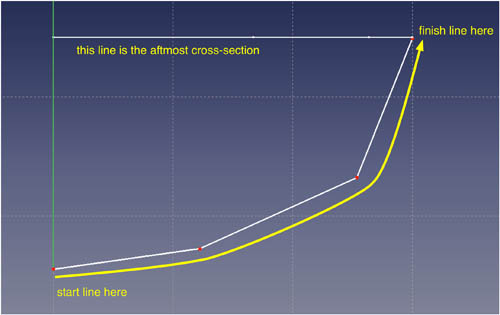
- use the same number of line segments as in the stemline Sketch
- save sketch
- for ease of identification it is probably worth naming the Sketch something like "transom sketch"
Das neue Dokument speichern
Now save the document which contains the Sketches that will define the hull shape, giving it some name that is descriptive
Once the Sketches have all been created and positioned, the document should look like this from the top view :
The principal limitations for constructing the model are:
- the stemline bottom should end at (0,0)
- the bottom centremost end of each cross-section should end at the Y axis - note that it can have any Z value
This concludes the first step which is one of creating the data which the macro will use to create both half-hulls and complete-hulls. The second step is described in the following section which is titled User Interface
Benutzeroberfläche
In this step the macro will gather some information from the user and then process the input Sketches to generate the desired hull models. This is the only GUI image for the macro and is primarily configuration details for the production of the hull models from the Sketches:
Die Auswahlmöglichkeiten im GUI-Fenster sind:
- Starboard half-hull: checking this will cause the macro to produce a starboard half-hull model
- Mounting plaque: if checked the macro will mount the half-hull on a plaque
- Allow space for keel: if checked will cause the half hull to be mounted higher on the plaque than the centre position, this is so a separately generated keel could be placed below the hull
- Port half-hull: checking this will cause the macro to produce a port half-hull model
- Mounting plaque: if checked the macro will mount the half-hull on a plaque
- Allow space for keel: if checked will cause the half hull to be mounted higher on the plaque than the centre position, this is so a separately generated keel could be placed below the hull
- Complete hull: checking this will cause the macro to produce a complete model
- Bottle for complete hull: if checked the macro will place the complete hull inside a transparent bottle (complete with cork)
- Allow space for keel: if checked will cause the half hull to be positioned higher in the bottle than the centre position, this is so a separately generated keel could be placed below the hull
- Bulkheads for flush deck: checking this will cause the macro to produce bulkheads whose tops are level with the top of the hull, bulkheads will not be generated for the most forward 2 cross-sections or the aft-most 2 cross-sections
- Bulkheads for coachhouse: checking this will cause the macro to produce bulkheads whose tops are possibly above the top of the hull.
- Bulkheads to skip at bow determines how many cross-sections will be left without a bulkhead at the bow
- Bulkheads to skip at stern determines how many cross-sections will be left without a bulkhead at the stern
- The dimensions of the top of the bulkheads will be configured as per the following diagram:
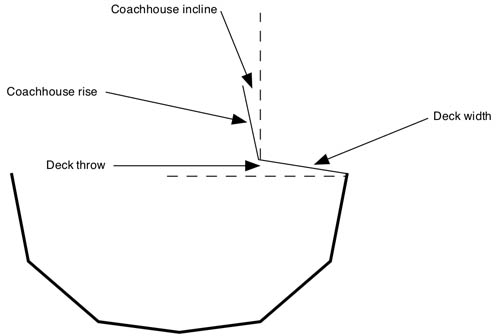
- Cancel button: the execution is halted and the window closes
- Re-Use Last File button: the execution uses the data file AND SETTINGS from the the last run, any changes to settings are ignored
- Select File button: the standard Open File window is opened where the user can either select a file or Cancel and exit
When the macro runs it takes configuring data from the user and then reads Sketcher sketches in the selected input file.
Hinweis: Während das Makro die Skizzen durchläuft, druckt es alle Ausnahmen sowie einige Meilensteine in der Berichtsansicht aus. Wenn man unerwartete Ergebnisse erhält oder Teile fehlen, sollte man wahrscheinlich zuerst hier nachsehen.
Optionen
There are various types of bows and sterns for boats, with sterns having much more variety than bows. Here are examples of transoms and bows from the real world alongside the similar macro output:
Sheer Stern
Wahrscheinlich der häufigste Hecktyp, typisch für alle Schiffsgrößen, von Handelsschiffen bis hin zu Ruderbooten.
Sugar-Scoop Stern
Most likely to be found on a sailing yacht, it is a product of designing to maximise the length of the waterline to benefit from class rules for racing under sail.
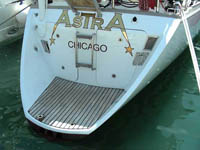 |
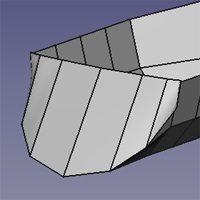 |
- place the aftmost 2 cross-sections as close as is feasible, then rotate the aftmost of the two through to an angle of 45 degrees (or whatever is called for) around the X-axis
Canoe Stern
Zu finden auf allen Arten von Wasserfahrzeugen, Motor- und Segelbooten, Freizeit- und Handelsbooten.
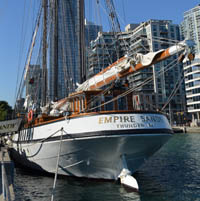 |
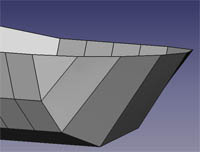 |
- place the aftmost 2 cross-sections as close as is feasible, then rotate the aftmost of the two through to an angle of 45 degrees around the X-axis
Normal Bow
Bei den Bugformen gibt es viel weniger Vielfalt als bei den Heckspiegeln:
Trireme Bow
Although not seen very frequently in the last 2 millenia, this was once the definitive bow profile for war-making vessels:
- in order for the bow to be correct the poly-line for the stemline needs to be drawn from the bottom to the top which will mean right to left in the Sketcher
Beispieldateien
Diese Dateien sind Beispiele für Skizzen-Daten, die mit dem Makro verwendet werden können. Es handelt sich dabei hauptsächlich um die Modelle für die Bildschirmaufnahmen im Abschnitt Optionen oben. Die Dateien funktionieren mit dem Makro und können daher heruntergeladen und an die spezifischen Anforderungen angepasst werden. Das Präfix 5x3 (zum Beispiel) bedeutet, dass das Modell 5 Querschnitte und 3 Liniensegmente pro Querschnitt (d. h. Skizze) hat.
To use one of the example files, right-click on the file link and select Save File As... from the menu. The filename will be specified, choose the desired folder/directory to hold the example file.
- 3x1 hull with the minimum number of Sketches (stemline, one cross-section, transom) with 1 line segment per Sketch <<<<< NOT CURRENTLY WORKING
- 5x3 with normal bow
- 5x3 with trireme bow
- 5x3 with canoe stern
- 5x3 with sheer transom stern
- 5x3 with sugar scoop stern
- 5x5 workboat
- 7x5 pirate boat
- 12x3 sailing yacht
Anmerkungen
- almost all the examples on this page are generated with only 3 line segments defining the side of the hull which gives a very faceted appearance, increasing the number of segments in each Sketch would generate a much smoother surface which would increase the realism
- doesn't do keels, skegs or rudders, in other words, it doesn't do any of the wet area
- doesn't do square bows like push-boats or towed barges
- doesn't do submarines (although it will do the lower half of a submarine)
Bekannte Probleme
The 'Ruled Surface' feature of FreeCAD is used to generate the hull sections from the Sketches. It can sometimes generate the wrong result and display a grater like surface instead of a smooth planar one. This will typically occur when the Sketches are rotated such as when a Sugar Scoop stern is modeled. Also angling a Sheer Transom stern can cause this. If it occurs then typically it will do so in either the half-hull models or the complete hull model - it never seems to occur in all three models for the same hull. Also it usually only happens at the extreme bow or stern. If it happens to section in the middle of the boat then most likely one of the Sketches was drawn in the wrong direction (i.e. either random sequence or top-down where as all lines should be drawn bottom-up)
It can usually be removed by using the following steps:
- in the Model tab of the Combo View, click on the faulty segment to select it, the faulty segment will show as highlighted on the display
- select the Data tab on the bottom half of the Combo View, the lower part of the window will have a Label "Ruled Surface" with a single parameter 'Orientation'
- there is a popup menu to the right which has the values 'Automatic', 'Forward', 'Reversed', it will initially be set to 'Automatic'
- try one of the other settings (remembering the faulty segment must still be selected in the upper part of the Combo View) which will usually correct the problem
Die folgende Bildschirmaufnahme zeigt den relevanten Teil des Bildschirms:
Zukünftige Möglichkeiten
- replace line segments of cross-sections with curved lines: this is just at the idea stage but would give a much smoother surface in the vertical dimension, however the horizontal surface would still be faceted as it is now
- integrate with Draft workbench to produce drawings from models: an initial goal, but the feasibility has not been investigated
- handle keels, skegs and rudders: one work around for keels with the present system is to model the keel as a half-hull on it's own and then assemble it onto the bottom of the main hull; this would still do nothing for rudders and skegs though
Glossar
As with any ancient and practiced trade, a rich and sometimes confusing vocabulary has developed around ships, boats and nautical practices. In describing this macro it is both awkward and inefficient to describe the process without using the correct and accurate terms. The obvious problem is that the average lay person will be unfamiliar with such terminology, hence this vocabulary:
| aft | the rear aspect of anything on a boat |
| chine | a planar facet of a hull, can be used to approximate a curved surface or as a finished building technique |
| coachhouse | the part of the central deck which is raised above the deck level - usually to accommodate increased headroom in the interior of the boat |
| flush deck | a deck that runs smoothly from the top of one side of the hull to the other, the converse to a coachhouse deck |
| forward | also 'fore'; the front aspect of anything on a boat |
| port | lefthand side looking forward |
| starboard | righthand side looking forward |
| stemline | the sloped vertical edge which is the bow of a hull |
| transom | the curved top edge of the stern face which can be flat or curved |
Verweise
- Half Hull Model Ship (Wikipedia)
- Why Half Hulls (Maritime Half Hull Ship Models and Nautical Art website)
- Traditional Model Yacht Design (US Vintage Model Yacht Group)
Skript
Macro_Half_Hull_Model.FCMacro
Dieses Skript läuft fehlerfrei. Aufgrund der Vielzahl möglicher Eingaben kann es jedoch bei einigen Eingaben zu Fehlern kommen. In diesem Fall melden Sie dies bitte.
Das Skript ist zu lang, um es im Wiki anzuzeigen, daher muss es kopiert oder heruntergeladen werden von ungekürzte Skriptdatei auf pastebin.com
